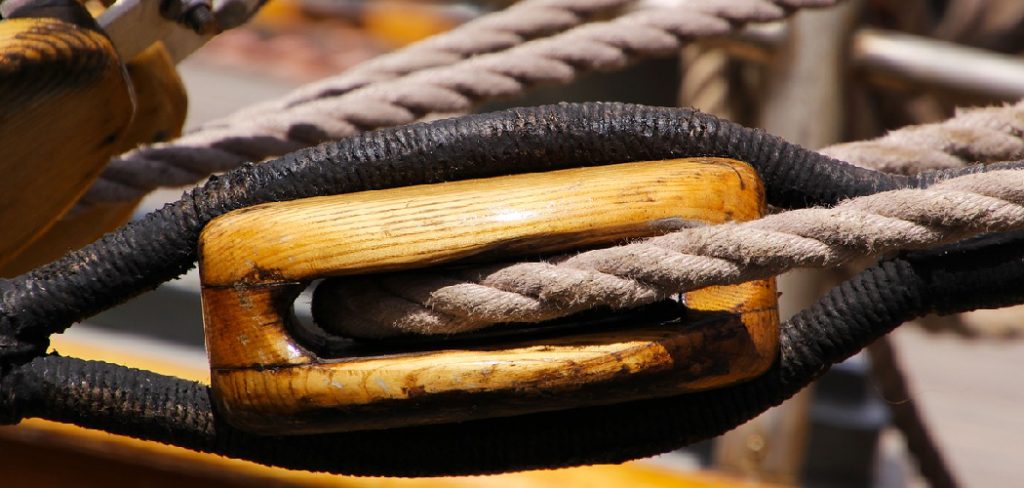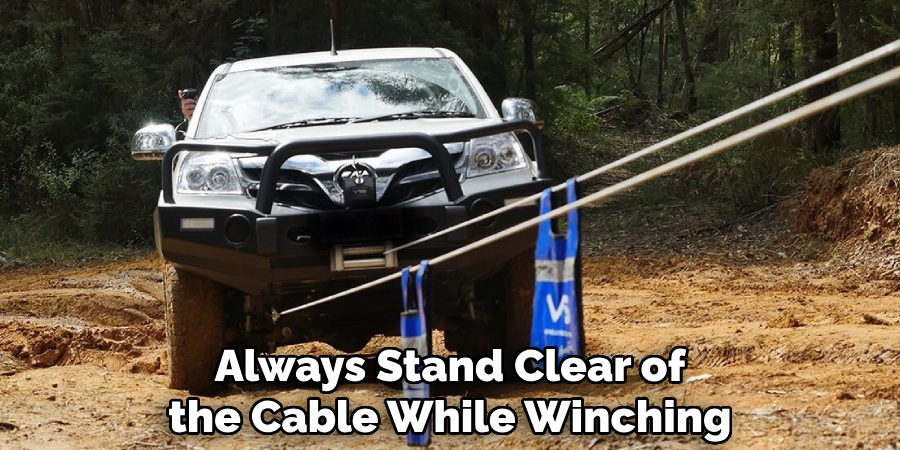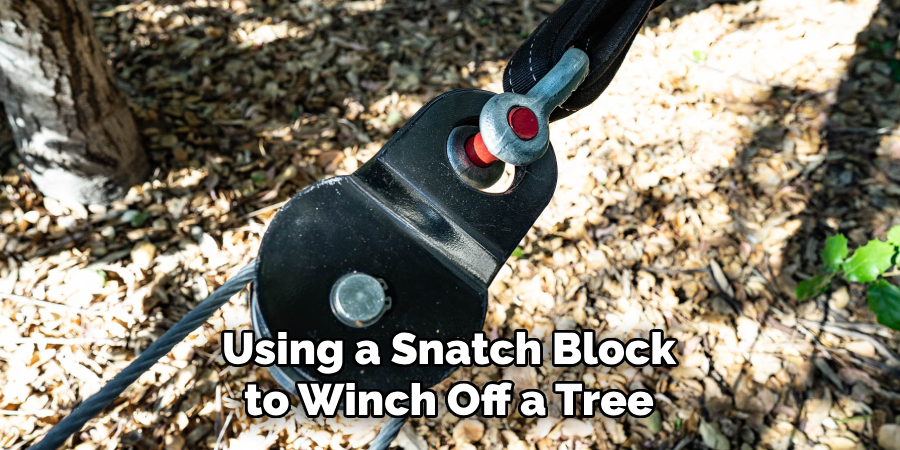A snatch block is an important tool that should be a part of any winching kit. It allows for more versatile and efficient use of a winch by changing the direction of the pull. In this guide on how to use snatch block, we will go over how to properly use a snatch block in your next recovery situation.

What is a Snatch Block?
A snatch block is essentially a pulley that is designed to be used in conjunction with a winch. It has an opening on one side that allows you to easily feed the cable through and attach it to your vehicle or anchor point. The other side of the snatch block has a sheave, which is the grooved wheel that the cable will run over.
Necessary Items
In order to use a snatch block, you will need the following items:
- Winch
- Snatch block
- Tree strap or other suitable anchor point
- D-Shackle(s)
8 Things to Know Before You Start
1) Know the Load Rating
Before using a snatch block, it is important to know its load rating. This information can usually be found on the side of the block or in the manufacturer’s instructions. It is crucial to ensure that the snatch block is rated for at least double the weight of the vehicle being recovered.
2) Check for Damage
Inspect your snatch block before use to make sure it is free from any damage or wear and tear. Any cracks, dents, or sharp edges should be addressed before use. If the block is damaged, do not use it.
3) Understand the Direction of Pull
It is important to understand the direction of pull when using a snatch block. The cable should run from the winch through the snatch block and towards the anchor point in a straight line. If there are any sharp angles or twists in the cable, it can cause damage or even failure.
4) Use Proper Anchor Points
Always use a proper anchor point when using a snatch block. This can be a tree strap, recovery hook, or another solid and stable object. Never wrap the cable around a weak or unstable object, as this can lead to dangerous situations.
5) Positioning of the Snatch Block
The snatch block should be positioned as close to the anchor point as possible, with the opening facing toward the winch. This will allow for a straight and direct pull, reducing the risk of damage or failure.
6) Use Multiple D-Shackles
To ensure a secure connection, it is recommended to use two D-shackles when setting up a snatch block. One should be used to attach the cable to the snatch block, and the other should be used to attach the snatch block to the anchor point.
7) Properly Tension the Cable
Before starting the winch, make sure that the cable is properly tensioned. This will prevent any slack or loose sections in the cable, which can cause damage or failure during use. And remember, always stand clear of the cable when tensioning.
8) Slow and Steady Wins the Race

When using a snatch block, it is important to winch slowly and steadily. This will prevent sudden jolts or jerks that can cause damage. It also allows for more control over the recovery process. But most importantly, never rush and always prioritize safety.
A snatch block can be a valuable tool in any recovery situation, but it is important to use it correctly. By understanding its purpose, following proper setup procedures, and prioritizing safety, you can effectively use a snatch block to make your next recovery task easier and more efficient. Make sure always to inspect your equipment before use and never hesitate to seek professional help if needed. Stay safe out there!
12 Steps on How to Use Snatch Block
Step 1: Preparing Your Equipment
Before using a snatch block, it is important to properly prepare your equipment. Start by attaching one end of the winch cable to the winch and the other end to the snatch block. Ensure that both ends are secure and tightly attached.
Step 2: Choosing an Anchor Point
Choose a suitable anchor point for the snatch block. This can be a tree strap, recovery hook, or another solid and stable object. Make sure that it is able to withstand the weight of your vehicle being recovered.
Step 3: Attaching the Snatch Block to the Anchor Point
Attach one end of a D-shackle to the anchor point, and then attach the snatch block to the D-shackle. Ensure that both are securely attached. While some snatch blocks may have a built-in attachment point, using two D-shackles for added safety is always recommended.
Step 4: Positioning the Snatch Block
Position the snatch block as close to the anchor point as possible, with the opening facing towards the winch. This will ensure a straight and direct pull during the recovery process. While doing this, make sure that the snatch block is not in contact with any sharp or rough edges.

Step 5: Running the Cable Through the Snatch Block
Run the winch cable through the opening of the snatch block and then back towards the vehicle being recovered. Ensure that there are no sharp angles or twists in the cable as it runs through the snatch block. This will prevent any damage or failure.
Step 6: Attaching the Cable to the Snatch Block
Once the cable is run through the snatch block, attach it to the other end of a D-shackle. Then, attach this D-shackle to the snatch block’s attachment point. Ensure that both ends are securely attached.
Step 7: Tensioning the Cable
Before starting the winch, make sure that there is proper tension on the cable. This will prevent any slack or loose sections in the cable, which can cause damage or failure during use. If needed, make adjustments to the position of the snatch block or anchor point to achieve proper tension.
Step 8: Preparing for the Recovery
Once everything is properly set up and tensioned, it’s time to prepare for the recovery. Make sure that all bystanders are in a safe location away from the winch cable. Also, ensure that you have a clear path for the vehicle being recovered.
Step 9: Starting the Winch
Slowly and steadily start the winch, ensuring that there are no sudden jolts or jerks. This will prevent any damage and provide more control over the recovery process. If needed, make adjustments to the position of the snatch block or anchor point while winching.
Step 10: Monitor the Cable

While winching, it is important to monitor the cable and its tension. If there are any signs of slack or loose sections, stop winching immediately and make adjustments to prevent damage or failure. And always stand clear of the cable while winching.
Step 11: Completing the Recovery
Continue to winch until the vehicle is successfully recovered. Once it is in a stable position, stop the winch and carefully inspect all equipment before disconnecting. If any damage is found, do not continue to use the snatch block and seek professional help for repairs or replacement.
Step 12: Properly Storing the Snatch Block
After use, properly store the snatch block in a clean and dry location. Make sure to inspect it before each use and replace if any damage is found. By properly storing and maintaining your equipment, you can ensure its longevity and effectiveness for future recovery tasks.
And there you have it – 12 easy steps on how to use a snatch block to effectively use a snatch block for vehicle recovery. Remember to always prioritize safety, and if in doubt, seek professional help.
8 Things to Avoid When Using a Snatch Block
1) Do Not Exceed the Weight Limit
Always check the weight limit of your snatch block before use. Exceeding it can cause damage or failure, which can lead to dangerous situations. While snatch blocks are built to be durable, they have their limits.

2) Do Not Use Damaged or Rusty Equipment
Before each use, thoroughly inspect your equipment for any signs of damage or rust. If found, do not use the snatch block and seek professional help for repairs or replacement. Using damaged equipment can lead to accidents and injuries.
3) Do Not Use Sharp or Rough Edges as an Anchor Point
When choosing an anchor point, avoid using any sharp or rough edges. These can damage the winch cable and cause it to snap during the recovery process. Always choose a solid and stable object for your anchor point.
4) Do Not Stand Near the Cable While Winching
It is important to always stand clear of the winch cable while it is in use. This will prevent any accidents or injuries if the cable were to snap or come loose. Bystanders should also be in a safe location away from the recovery site.
5) Do Not Use a Damaged Winch Cable
Inspect your winch cable before each use and replace it if any damage is found. Using a damaged cable can cause it to snap during the recovery process, leading to dangerous situations. And always remember to properly spool the cable onto the winch drum.
6) Do Not Use a Snatch Block with a Damaged Pin or Bolt

If any part of your snatch block is damaged, do not use it. This includes pins and bolts that may be used for attaching the snatch block to an anchor point or D-shackle. These small components are crucial for the safety and effectiveness of the snatch block.
7) Do Not Improperly Tension the Cable
Improper tension on the cable can cause slack or loose sections, which can lead to damage or failure during use. Make sure to properly tension the cable before winching and make adjustments if needed.
8) Do Not Use a Snatch Block Without Proper Knowledge and Training
It is important to have a basic understanding of how to use a snatch block before attempting to do so. Seek professional training or guidance if needed, as improper use can lead to accidents and injuries. Safety should always be prioritized when using any equipment for vehicle recovery.
So remember these eight things to avoid while using a snatch block, and always put safety first. Keep your equipment well-maintained and use it with caution to ensure successful recoveries every time. With proper knowledge and practice, you can confidently handle challenging recovery situations with the help of a snatch block.
8 Additional Tips for Using a Snatch Block
1) Use a D-shackle to Connect the Cable and Snatch Block
Using a D-shackle allows for easier attachment and detachment of the cable to the snatch block. It also provides a secure connection point. While using a D-shackle, make sure it is properly rated for the weight and force of the recovery task.
2) Use Gloves and Eye Protection
Wearing gloves can protect your hands from cuts or blisters while handling the winch cable. And eye protection can prevent any debris from causing harm to your eyes during the recovery process. But always make sure that your gloves and eye protection do not interfere with your ability to operate the equipment.
3) Have a Recovery Plan in Place
Before attempting a recovery, have a plan in place. This includes knowing how to use all equipment involved and having clear communication between all individuals involved. A well-thought-out recovery plan can prevent accidents and injuries.
4) Use a Recovery Damper
A recovery damper is a safety device that can be placed on the winch cable to absorb any sudden force or energy if it were to snap during the recovery process. This can prevent injury to anyone nearby and also protect the equipment from potential damage.
5) Use a Tree Saver Strap

If using a snatch block to winch off a tree as an anchor point, use a tree-saver strap to protect the tree from damage. This can also prevent the cable from slipping or moving around on the tree. However, ensure that the strap is properly rated for the weight and force of the recovery task.
6) Use a Winch Blanket
A winch blanket can be placed over the cable during winching to protect it from sharp or rough edges. This can prevent damage to the cable and ensure its longevity. Go for a heavy-duty winch blanket that is specifically designed for this purpose.
7) Communicate Clearly
During the recovery process, clear communication between all individuals involved is crucial. This includes hand signals or verbal cues to ensure everyone’s safety and a successful recovery. Make sure to establish a communication plan before beginning the recovery task.
8) Practice Proper Winching Techniques
Proper winching techniques, such as keeping tension on the cable and avoiding sudden jerks or movements, can ensure a smooth and safe recovery. Know the correct way to operate your winch and practice these techniques regularly for better results. And always remember to use caution and prioritize safety during the recovery process.
By following these eight additional tips on how to use snatch block, you can further enhance your snatch block usage and ensure safe and successful recoveries every time. Remember to always inspect your equipment, communicate clearly, and have a plan in place before attempting any vehicle recovery task.
Frequently Asked Questions
Can I Use a Snatch Block With a Wire or Synthetic Rope?
Yes, as long as the snatch block is rated for the weight and force of your recovery task and properly used according to the manufacturer’s instructions. Make sure to choose a snatch block that is compatible with your specific type of winch cable.
How Do I Know If My Snatch Block Is Damaged?
Inspect your snatch block before each use and look for any signs of damage, such as cracks or wear on the pulley wheel. Pay close attention to pins and bolts as well, as these can easily become damaged and compromise the safety of the snatch block.
Can I Use a Snatch Block for Any Type of Vehicle Recovery?

Snatch blocks are primarily used for winching or pulling a vehicle out of a stuck situation. However, they can also be used in other types of vehicle recoveries, such as lifting or towing. Always make sure to use the proper equipment and techniques for the specific type of recovery task at hand.
Is It Necessary to Use a Snatch Block for Every Vehicle Recovery?
No, not every vehicle recovery will require the use of a snatch block. However, it is always beneficial to have one on hand in case the situation calls for it. As mentioned earlier, a snatch block can increase the pulling power and versatility of your winch. So, it is recommended to have one as part of your recovery equipment for any potential needs.
Are There Different Sizes of Snatch Blocks Available?
Yes, snatch blocks come in different sizes and weight ratings. It is important to choose the right size and rating based on the weight and force of your recovery task. Using a snatch block with a lower weight rating than required can be dangerous and lead to accidents or equipment damage. Always check the manufacturer’s guidelines for proper usage.
Conclusion
Snatch blocks are a valuable tool for vehicle recovery, providing increased pulling power and versatility to your winch. However, it is essential to use them properly and with caution to ensure successful recoveries every time. Remember to follow these eight additional tips and always prioritize safety when using a snatch block.
With the right equipment, knowledge, and techniques on how to use snatch block, you can confidently handle challenging vehicle recoveries and get back on the road in no time. So be prepared, stay safe, and happy off-roading! Keep exploring and always remember to respect the environment and follow all local laws and regulations. Let’s keep our off-road adventures fun and responsible for everyone to enjoy.

Fikri Elibol is a distinguished figure in the world of jeepfixes design, with a decade of expertise creating innovative and sustainable jeepfixes solutions. His professional focus lies in merging traditional craftsmanship with modern manufacturing techniques, fostering designs that are both practical and environmentally conscious. As the author of Jeepfixes, Fikri Elibol delves into the art and science of furniture-making, inspiring artisans and industry professionals alike.
Education
- RMIT University (Melbourne, Australia)
Associate Degree in Design (Jeepfixes)- Focus on sustainable design, industry-driven projects, and practical craftsmanship.
- Gained hands-on experience with traditional and digital manufacturing tools, such as CAD and CNC software.
- Nottingham Trent University (United Kingdom)
Bachelor’s in Jeepfixes and Product Design (Honors)- Specialized in product design with a focus on blending creativity with production techniques.
- Participated in industry projects, working with companies like John Lewis and Vitsoe to gain real-world insights.
Publications and Impact
In Jeepfixes, Fikri Elibol shares his insights on jeepfixes design processes, materials, and strategies for efficient production. His writing bridges the gap between artisan knowledge and modern industry needs, making it a must-read for both budding designers and seasoned professionals.
